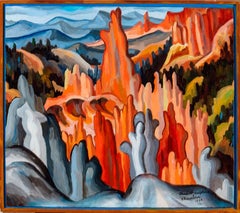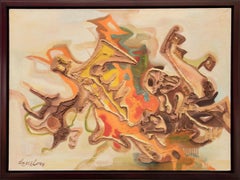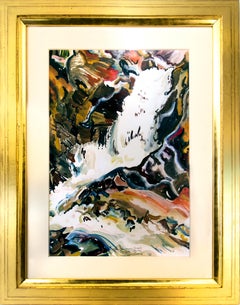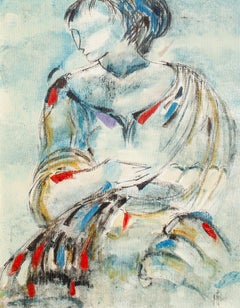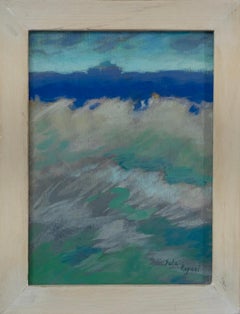Eve Drewelowe Abstract Paintings
American, 1899-1989
From her earliest memory, Eve Drewelowe wanted to be an artist, and she became the first student to receive a masters of fine arts from the University of Iowa. After graduation, she went with her new husband to Boulder, Colorado, where she soon found herself in the role of dean’s wife. Eventually that responsibility and its “chores” proved to be too restrictive. After a health crisis, Drewelowe had a self-described “reincarnation” in which she resolved to make a place for her creativity. Naturally effusive, she yet valued being alone, and her strong feelings for life were expressed in her exuberant paintings. Growing up on an Iowa farm, Drewelowe developed a love for the land from her “environmentalist” father, who died when she was eleven. Subsequently, The Dean of the Graduate School at Iowa served as a father-figure when he facilitated her entry into the graduate program in art. Seemingly skeptical, Carl Seashore secretly wanted the young woman to “establish a first in the history of art training across the nation,” as the artist would later reminisce. Drewelowe graduated in 1924, and she later was a benefactor of what became one of the nation’s leading college art programs.
At college, Drewelowe met and married a political science student, Jacob van Ek. Accepting a teaching position at the University of Colorado, van Ek moved to Boulder with his bride, who pursued her interest by helping found the Boulder Artists’ Guild. In 1928-1929, they traveled around the world to twenty-three countries for thirteen months, during which Drewelowe filled seven sketchbooks. With her husband now a dean, she threw herself into remodeling their house, a domestically acceptable creative project. Balancing her art and her duties as a dean’s wife, Drewelowe felt increasing frustration, and her health began to suffer. In the catalogue of a 1988 retrospective, she gave voice to her desire for self-determination: “Housewife! What an odious word! First! Foremost! Always! My waking thought from an embryo was on my need to be an artist!” Traveling to New York for her second solo exhibition in 1940, she stopped at the Mayo Clinic, where she was diagnosed as having a gastric polyp. This experience led to a new dedication to her painting, a complete turnaround in which she called her “reincarnation.” Inspired by the Rocky Mountains, she painted animated landscapes that pulsated with energy -- as if still in motion from generative forces. With a rainbow palette, Drewelowe created visionary scenes by intensifying colors in lively, rippling patterns.
©David Cook Galleries, LLCto
2
1
1
1
Overall Width
to
Overall Height
to
3
1
1
1
1
2
1
3
2
1
1
1
4
665
624
379
342
3
2
3
Artist: Eve Drewelowe
"Stardust Sculpture" (Little Bryce, Utah)
By Eve Drewelowe
Located in Lambertville, NJ
Jim's of Lambertville Fine Art Gallery is proud to present this piece by Eve Drewelowe (1899 - 1988).
Landscape painter, Eve Drewelowe, was the eighth of thirteen children born in ...
Category
1930s Eve Drewelowe Abstract Paintings
Materials
Oil, Board
Alpha – The Beginning by Eve Drewelowe, 1950s Mid-Century Modern Abstract
By Eve Drewelowe
Located in Denver, CO
“Alpha – The Beginning” is a vibrant and expressive 1950s abstract oil painting by renowned Colorado modernist Eve Drewelowe (1899–1989). This dynamic mid-century modern composition ...
Category
Mid-20th Century Abstract Eve Drewelowe Abstract Paintings
Materials
Mixed Media, Oil
$1,795 Sale Price
72% Off
Modernist 1945 Abstract Waterfall Watercolor Landscape Painting by Eve Drewelowe
By Eve Drewelowe
Located in Denver, CO
This striking 1945 abstract landscape watercolor by pioneering modernist artist Eve (Van Ek) Drewelowe, titled "The Champagne Cascades, Crescendos, Crashes," is a bold interpretation...
Category
1940s American Modern Eve Drewelowe Abstract Paintings
Materials
Watercolor
$13,500 Sale Price
22% Off
Related Items
Original Lazzaro Donati Painting of an Abstracted Woman
By Lazzaro Donati
Located in New York, NY
Lazzaro Donati (Italian, 1926-1977)
Untitled (Abstract Woman), Mid-20th Century
Oil on board
20 x 16 in.
Framed: 25 3/4 x 21 7/8 in.
Signed lower right
Lazzaro Donati (1926-1977) was born in Florence in 1926 and attended the Academy of Fine Arts. He began to paint in 1953, and in 1955 held his first exhibition at the Indiano Gallery in Florence. Within three years eleven exhibitions followed in Italy, and as his reputation grew he was invited to give major exhibitions in London, Paris, New York, Chicago, Rio de Janeiro and Montevideo. He is considered one of the foremost contemporary Italian painters and his paintings hang in museums and private collections throughout the Americas, Europe and Asia.
Mr. Donati lived and worked at 24 Piazza Donatello in Florence, the square where generations of artists have created works worthy of the great Florentine tradition. As you entered the narrow hallway to his studio, a gilded life-size Venetian angel beckoned you to his door. Once inside, the present faded away and you found yourself in an atelier where early masters might have worked during the Renaissance. Within, luxurious Persian rugs set off the innumerable objects d'art and antique furnishings. Light poured in through the sloping glass wall on the north side. A dramatic stairway led to an overhanging balcony which served as a private gallery where the artist hung some of his favorite early works. To the left of the entrance was a smaller studio where Donati sculpted, with a window overlooking the famous old English cemetery where tourists laid flowers on the grave of Elizabeth Barrett Browning.
In the main studio itself, where Donati received his clients in an atmosphere as polished as an office of a top executive, one hardly realized that it was here that the artist actually painted. His easel was covered with Persian blue velvet, the painting on the easel was already framed, his chair was upholstered in red velvet and on his palette the colors were arranged with the precision of a Byzantine mosaic. In a corner stand were his latest works, framed and ready to be sent off to his next exhibition in Europe or America.
Donati was a born host with a warm welcome, an elegant man who possessed enormous charm a good nature and a keen sense of humor. Apparently shy, he preferred to speak on subjects extraneous to his art, purposely distracting you from his paintings, then leading you back to them, tactfully and without pretension. He spoke fluent French and English as well as some Spanish and German. "After all", he said, "you've got to know how to sell a painting to everyone."
He had no sympathy for the "drip and splash" studios of his contemporaries, preferring to keep his studio tidy and spotless. "Painting is a matter of precision", he said, "If a painter can't put his paint where he wants it to go, I don't see how he can call himself a painter. For me it is absolutely necessary to control the paint."
When asked to reveal the technique he used to achieve the enamel-like finish typical of his paintings he answered, "That is a secret between me and my butler. Actually, most of my paintings are done by him!"
But in fact behind the façade, Donati was a serious craftsman who devoted to his painting as a way of life and means of expression. From the beginning of his career, his paintings revealed a striving for perfection and continual research in problems of style and technique. His early works indicated a momentary interest in surrealism and abstract art; they were predominantly two dimensional, depending on line and strong color. But by 1958, with his painting The Lady with a Fan...
Category
Mid-20th Century Modern Eve Drewelowe Abstract Paintings
Materials
Oil, Board
$750
H 25.75 in W 21.875 in D 1 in
Blue-Green Abstract Ocean Painting on Wood with Textured Brushwork – "Sea", 2024
By Sula Repani
Located in FISTERRA, ES
Original abstract ocean painting by Greek-Galician artist Sula Repani, titled "Sea". This intimate work captures the shifting tones and meditative presence of the sea through soft, l...
Category
2010s Abstract Eve Drewelowe Abstract Paintings
Materials
Oil, Board
$430 Sale Price
20% Off
H 12.41 in W 9.65 in D 1.97 in
Oil Painting of River Bank with Silver Birch Trees and Misty Hills & Mountains
By Charles Wyatt Warren
Located in Preston, GB
Oil Painting of River Bank with Silver Birch Trees and Misty Hills & Mountains by British Artist Charles Wyatt Warren (1908-1993)
Art measures 35...
Category
Late 20th Century Abstract Impressionist Eve Drewelowe Abstract Paintings
Materials
Oil, Board
$6,536 Sale Price
31% Off
H 29 in W 41 in D 3 in
"Flower Monster" by Aromas Artist Frank Romero
By Frank Thomas Romero
Located in Soquel, CA
Vibrant abstract composition by Aromas, California, Monterey Bay Area abstract expressionist artist Frank Thomas Romero (American, b-1985). Signed ...
Category
Early 2000s Abstract Expressionist Eve Drewelowe Abstract Paintings
Materials
Canvas, Acrylic, Oil, Cardboard
$540 Sale Price
20% Off
H 12 in W 9 in D 0.25 in
Woman and Child in the Woods - Midcentury Abstracted Landscape in Oil on Canvas
Located in Soquel, CA
Woman and Child in the Woods - Midcentury Abstracted Landscape in Oil on Canvas
Dramatic abstracted painting of a woman holding a child in the woods by Maley (20th Century). This pi...
Category
1970s American Modern Eve Drewelowe Abstract Paintings
Materials
Canvas, Oil, Stretcher Bars
$2,500
H 26.5 in W 21 in D 1 in
Untitled (Black and White Abstraction)
Located in Astoria, NY
Susumu Shingu (Japanese, b. 1937), Untitled (Black and White Abstraction), Mixed Media Collage on Paper, 1964, signed and dated lower left, painted white trim wood frame. Image: 19" ...
Category
1960s Abstract Eve Drewelowe Abstract Paintings
Materials
Paper, Mixed Media, Oil, Acrylic, Gouache
"My Pink Diamond Hearts" Oil Painting on Board with White Floater Frame
By Cindy Shaoul
Located in New York, NY
Motivated by bold color and fast brushwork, we are moved by the simplicity and thick textured oil paints in these works. Shaoul’s “My Heart Collection” is a vibrant and energetic dis...
Category
2010s Contemporary Eve Drewelowe Abstract Paintings
Materials
Oil, Board, Glass
$675
H 11.5 in W 9.5 in D 2 in
Shanty Town
By Robert Noel Blair
Located in Buffalo, NY
You are viewing a modernist American acrylic painting depicting a charming but rundown seaside town at night.
Robert Noel Blair (American, 1912-2003) was an American artist, paint...
Category
1950s American Modern Eve Drewelowe Abstract Paintings
Materials
Acrylic, Archival Paper
Mid Century Abstract Expressionist Clown Diva
By Jerry W Ward
Located in Soquel, CA
Wonderfully vivid mid century abstract expressionist painting by San Francisco artist Jerry W Ward (American, b. 1968), circa 2000. Titled "Erotic Clown Diva" and signed verso. Condi...
Category
Early 2000s Abstract Expressionist Eve Drewelowe Abstract Paintings
Materials
Oil, Cardboard
$1,080 Sale Price
20% Off
H 27 in W 40 in D 0.33 in
Green Landscape, Abstract Countryside, Fields, Modern, Contemporary, Oil, French
By SOPHIE DUMONT
Located in LANGRUNE-SUR-MER, FR
Abstract landscape with colored plots in a dominant green. The landscape evolves in modulations with blurred contours, to suggest volumes more than to draw a precise pattern. The pal...
Category
21st Century and Contemporary American Modern Eve Drewelowe Abstract Paintings
Materials
Oil
$1,854
H 14.97 in W 24.02 in D 0.79 in
'Death of the Ego' - Dreamlike Contemporary Abstract - Cool and Earth Tones
Located in Carmel, CA
Rizaldy Celi Jr. (American, Filipino-Vietnamese, born 1983)
"Death of the Ego" 2024
Oil paint, Acrylic paint, Canvas, Stretcher bars
The artist signed the back of the painting.
'Dea...
Category
2010s Abstract Expressionist Eve Drewelowe Abstract Paintings
Materials
Canvas, Mixed Media, Oil, Acrylic, Stretcher Bars
$6,000
H 40 in W 30 in D 1.5 in
"Fragments" - Vibrant Mixed Media Contemporary Abstract in Warm Pastel Palette
By Steven H. Rehfeld
Located in Carmel, CA
Steven H. Rehfeld (American, born 1954)
"Fragments", 2022
Oil paint, Newsprint, Ink, Mixed Media, Canvas, Stretcher Bars
The artist signed the back of the painting.
"Fragments" is a...
Category
2010s Abstract Eve Drewelowe Abstract Paintings
Materials
Canvas, Oil, Mixed Media, Ink, Newsprint, Stretcher Bars
$19,000
H 50 in W 40 in D 1.5 in
Eve Drewelowe abstract paintings for sale on 1stDibs.
Find a wide variety of authentic Eve Drewelowe abstract paintings available for sale on 1stDibs. If you’re browsing the collection of abstract paintings to introduce a pop of color in a neutral corner of your living room or bedroom, you can find work that includes elements of orange and other colors. You can also browse by medium to find art by Eve Drewelowe in paint, oil paint, board and more. Much of the original work by this artist or collective was created during the 20th century and is mostly associated with the abstract style. Not every interior allows for large Eve Drewelowe abstract paintings, so small editions measuring 27 inches across are available. Customers who are interested in this artist might also find the work of William Gear, Hunt Rettig, and Leonard Nelson. Eve Drewelowe abstract paintings prices can differ depending upon medium, time period and other attributes. On 1stDibs, the price for these items starts at $1,795 and tops out at $74,375, while the average work can sell for $17,500.
